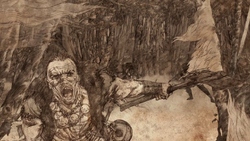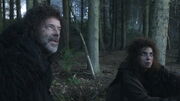No edit summary |
|||
| Line 39: | Line 39: | ||
{{reflist}} |
{{reflist}} |
||
{{Creatures}} |
{{Creatures}} |
||
| + | |||
| + | [[de:Die ersten Menschen]] |
||
| + | [[ru:Первые люди]] |
||
[[Category:Peoples]] |
[[Category:Peoples]] |
||
[[Category:History]] |
[[Category:History]] |
||
Revision as of 16:03, 5 September 2013

The First Men arrived in Westeros 12,000 years ago.
The First Men are the original human inhabitants of Westeros. They ruled the continent for millennia before the Andals invaded from the eastern continent of Essos. The Andals overran most of southern Westeros, but failed to take the North. While the blood of the First Men and the Andals has intermingled over thousands of years of dynastic marriages, the inhabitants of the North have the greatest amount of First Men blood in their veins.[1][2]
History
Arrival in Westeros, the Pact, and the Age of Heroes
The First Men invaded Westeros some twelve thousand years before the events of the series, crossing via a land-bridge from Essos in the vicinity of modern Dorne. They were resisted by the Children of the Forest, a semi-mythical diminutive race who ruled Westeros alone at this time. The Children, using magic, destroyed the land-bridge (forming the modern peninsula of Dorne and the shattered islands known as the Stepstones beyond) but were pushed back over the course of many years of warfare. Eventually, the First Men and the Children forged the Pact, signed on the Isle of Faces at the center of the vast lake known as Gods Eye. The First Men began to forge numerous kingdoms across the continent.[2]
The two races coexisted peacefully for four thousand years before both came under attack from the White Walkers, a mysterious race of ice and cold from the uttermost north. In the War for the Dawn, the First Men and the Children unified to throw back the invasion. With the aid of giants and the Children, Bran the Builder built the Wall and would then build Winterfell and rule as the first King in the North. After this war the Children began dwindling in numbers, with the last of them disappearing around the time that the Andals invaded Westeros, two millennia after the War for the Dawn according to tradition.[2]
The Andal Invasion of Westeros
The Andals overran and conquered all of Westeros over a period of more than a thousand years. Their attempts to conquer the North were defeated at every turn, and eventually the Andals and First Men made peace. The results of the Andal invasion varied from region to region. In the Vale of Arryn, the First Men were all but wiped out, and today the nobility of the Vale are considered to have the purest Andal bloodlines in all of Westeros. In many other regions, the Andals established themselves as the new aristocratic class ruling over the First Men, though after thousands of years these ethnic lines have blurred to a large extent. Some of the noble Houses of the First Men survived by intermarrying with Andal invaders: even House Lannister possesses some First Men blood, through the female line. The Andals that invaded the Westerlands married the female descendants of Lann the Clever, a legendary hero of the First Men, and House Lannister descends from this union. In the Riverlands, House Blackwood and House Bracken are also dynasties of First Men that survived by intermarrying with the Andal invaders, and today are of mixed ethnicity.[2]
The descendants of the First Men

Northerners such as Rickard Karstark and Ned Stark are descended from the First Men
Many of the people living in Westeros have at least some blood of the First Men in their ethnic makeup, though this is more common in the lower classes. Even so, the southern kingdoms of Westeros became so thoroughly dominated by the Andals and their culture that Westeros is often referred to in Essos as "the Land of the Andals". Two groups in Westeros, however, still claim majority descent from the First Men, and still actively embrace the old ways and religion of their ancestors: the Northerners and the wildlings. Ties of dynastic marriage were made between the North and the southern kingdoms over the next six thousand years, so that the blood of both peoples mingled together, a process that has continued under the rule of the Targaryen kings. For example Ned Stark, of the ruling dynasty of the First Men of the North, married Catelyn Tully, of the predominantly Andal ruling dynasty of the Riverlands, resulting in all of their children having mixed blood. Still, while the Kingdoms south of the Neck consist of heavily mixed Andal and First Men ethnicity, the North is still predominantly First Men.

The wildlings are also descended from the First Men, more so than their distant cousins in the Stark-held North
The Wildlings that live north of the Wall are descended from those First Men who were living north of the Wall when it was constructed, and have an even purer bloodline than the North: there is little, if any, Andal blood north of the Wall.[3] Even in the Stark-held North, the usage of the language of the First Men - the Old Tongue - was eventually discontinued in favor of adopting the language of their Andal neighbors to the south. However, the language of the First Men is still actively used North of the Wall (though a large number of Wildings also know the Common Tongue of the Andals).
In the books
In the A Song of Ice and Fire novels, the First Men living in the North were able to resist the Andal invasion due to the geographical choke point of the Neck which separates the North from the rest of the continent. The powerful fortress of Moat Cailin commands the approach to the North through the swamps of the Neck. The only major road that large armies can use to travel North through the Neck is so well defended by Moat Cailin that the Kings of Winter were able to consistently repulse Andal attempts to invade their lands.
To be clear: the "First Men" are not the first humans who lived in the entire world. Humans were already living on the eastern continent of Essos for untold millennia (and probably also on Sothoryos, the Africa-like continent south of Essos). The exact origins of the human race are not known, because just as in real life, written history does not extend that far back. Even oral history eventually fades into varying fables, legends, and religious explanations for the origins of humans. The "First Men" are simply the first humans that migrated to the western continent of Westeros.
Author George R.R. Martin has stated that the series was loosely inspired by the War of the Roses which occurred in Britain during the fifteenth century. The First Men loosely parallel the original Celtic inhabitants of Britain, while the Andals who later invaded and conquered Westeros are loosely parallel to the Anglo-Saxon invasions of Britain during the fifth and sixth centuries. The Anglo-Saxons never conquered the Celtic peoples living in the region that would become modern Scotland, in the north of the island of Britain, who remained ethnically and culturally distinct. Similarly, the Stark-held North resisted the invasion of the Andals from the south, and like Scotland remained ethnically and culturally distinct. The Anglo-Saxons did intermingle on some level with the Celtic/Romano-British inhabitants of what would become modern England, but they were subjugated and largely subsumed by the Anglo-Saxons. Similarly, people in the southern kingdoms of Westeros have some partial descent from the First Men, in regions where the Andals conquered and intermingled with the First Men instead of wiping them out entirely.
See also
References
Template:Creatures
